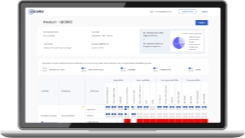
In today's technologically-driven corporate landscape, integrating human resources with IT systems has birthed the indispensable realm of HRIS—Human Resource Information System.
At its core, HRIS streamlines and optimizes HR operations by centralizing employee data, automating manual tasks, and facilitating strategic, data-driven decisions. Its significance in modern HR operations cannot be overstated, acting as the digital backbone that supports everything from recruitment to payroll to performance management.
Central to this ecosystem is a pivotal figure: the HRIS Analyst. As the bridge between human resources and IT, the HRIS Analyst ensures that the system is functional, efficient, user-centric, and aligned with organizational objectives.
In this blog, we'll delve deeper into the key roles and responsibilities of an HRIS Analyst, shedding light on the intricacies of their work and the pivotal role they play in modern HR management.
Key Roles and Responsibilities of an HRIS Analyst
In modern Human Resource operations, the HRIS Analyst emerges as a linchpin, orchestrating the seamless functioning of HRIS systems that synchronize people processes with technological prowess. As organizations continue to invest in digital HR solutions, the demand for HRIS Analysts has surged, making them pivotal to HR's technological metamorphosis.

A study by Deloitte highlighted that over 40% of global organizations are in the process of implementing or upgrading their HR systems. Given this digital thrust, what exactly does the role entail? Here's a deep dive into their multifaceted roles and responsibilities:
1. System Implementation and Maintenance:
- Project Management: Oversee the full life cycle of HRIS implementation projects, from scoping to deployment, ensuring that milestones are met and that the end product aligns with organizational objectives.
- Software Updates: Keep abreast of software updates released by vendors. Ensure these updates are tested in a controlled environment before deploying to the live system to maintain system reliability.
- Troubleshooting: Act as the first line of defense against system disruptions. Quickly identify root causes of issues and devise immediate solutions to minimize downtime.
- Customization: Work closely with HR teams to modify HRIS interfaces, workflows, and features to reflect and cater to the organization's evolving needs.
- Continuous Improvement: Actively solicit user feedback and closely monitor system performance metrics. Use this data to make informed decisions about potential system adjustments or enhancements.
2. Data Management and Integrity:
- Data Entry Protocols: Set up strict data entry guidelines, ensuring that the data entered into the system adheres to a predefined standard, thus reducing inconsistencies and errors.
- Regular Audits: Systematically review the data in the HRIS, looking for discrepancies or inaccuracies, and ensuring that management decisions are based on reliable data.
- Backup Procedures: Design and implement rigorous data backup protocols. Regularly test these backups to ensure data can be restored when necessary.
- Data Cleanup: Use tools and manual checks to find anomalies, ensuring that redundant, outdated, or trivial data does not clutter the system.
- Migration: Lead efforts when transitioning to a new HRIS or integrating additional modules, ensuring data is transferred securely and accurately.
3. Reporting and Analysis:
- Custom Reports: Liaise with departments to understand their data needs, creating bespoke reports that provide insights relevant to their goals.
- Data Analysis: Dive deep into HR metrics, using statistical tools to decode patterns, thereby offering actionable insights to the HR team.
- Trend Forecasting: Predict future HR trends by extrapolating current data, aiding in proactive decision-making.
- Dashboard Maintenance: Develop visually engaging and intuitive dashboards, making real-time data accessible to stakeholders.
- Feedback Collection: Engage regularly with report users, ensuring that the data they receive is relevant and aiding them in their strategic planning.
4. Training and Support:
- Training Sessions: Curate comprehensive training modules tailored for different user groups, ensuring they can harness the full power of the HRIS.
- Documentation: Draft detailed user manuals with step-by-step guides, screenshots, and best practices to ensure even novice users can navigate the system confidently.
- Help Desk: Offer timely support, addressing user queries and concerns, ensuring minimal disruption to HR operations.
- Feedback Loop: Establish channels through which users can relay their experiences and challenges with the system, fostering a culture of continuous learning and improvement.
- Stay Updated: Attend seminars, workshops, and courses to remain at the forefront of HRIS advancements, ensuring that the organization always has cutting-edge expertise.
5. Integration and Collaboration:
- Cross-Functional Collaboration: Partner with IT, finance, and other departments, ensuring that HRIS integrates seamlessly with other enterprise software, providing a unified user experience.
- Vendor Relations: Forge strong relationships with HRIS software providers, ensuring swift support and understanding of future product roadmaps.
- API Management: Monitor and manage Application Programming Interfaces (APIs) that link HRIS with other tools, ensuring data flows smoothly across platforms.
- Stakeholder Communication: Regularly update organizational leaders on the status, changes, or challenges associated with the HRIS to ensure alignment.
- Feedback Mechanism: Design channels for various departments to voice their needs or concerns regarding HRIS functionalities, ensuring holistic satisfaction.
6. Security and Compliance:
- Access Control: Set stringent access controls, ensuring that sensitive data is accessible only to those who need it, reducing the risk of breaches or leaks.
- Data Privacy: Regularly review and update protocols to ensure alignment with data protection laws, ensuring the organization remains compliant and avoids legal repercussions.
- System Audits: Collaborate with cybersecurity teams to perform routine system audits, proactively identifying and mitigating potential security threats.
- Policy Development: Draft, disseminate, and update security and usage policies related to the HRIS, ensuring that all users are aware of their responsibilities.
- Stay Updated: Monitor changes in data security and compliance landscapes, adapting the HRIS as necessary to align with best practices and legal requirements.
Skills Required for HRIS Analysts
Human Resource Information System (HRIS) Analysts specialize in the intersection between human resource management and information technology. As such, they require a blend of skills from both domains. Here are the skills typically required for HRIS Analysts:
1. Technical Proficiency
- Database Management: Familiarity with database structures, queries, and reporting.
- Systems Knowledge: Proficiency with HRIS systems like Workday, PeopleSoft, ADP, SAP SuccessFactors, etc.
- Excel Skills: Many HR tasks can be made easier with advanced Excel skills, including pivot tables, lookups, and macros.
- Programming/Scripting: Basic programming languages or scripting understanding can benefit custom report generation or system integration.
- Data Analysis Tools: Familiarity with Tableau, Power BI, or other data visualization tools.
2. Project Management
- Ability to manage multiple tasks, timelines, and stakeholders.
- Familiarity with project management tools and methodologies.
Read More: Interpersonal Skills in Project Management: 📘 2023 Guide
3. HR Domain Knowledge
- HR Processes: Understanding key HR functions like recruitment, onboarding, benefits administration, payroll, performance management, etc.
- Legal & Compliance: Awareness of employment laws, privacy regulations, and other compliance requirements relevant to HR data.
4. Analytical Skills
- Data Analysis: Ability to collect, interpret, and visualize large datasets.
- Critical Thinking: Evaluate HR processes and recommend areas of improvement.
- Problem-Solving: Diagnose system issues or irregularities and find appropriate solutions.
5. Communication Skills
- Written Communication: Ability to produce clear documentation, training materials, and reports.
- Verbal Communication: Ability to explain technical concepts to non-technical users and gather user requirements effectively.
- Stakeholder Management: Manage expectations and requirements with technical and non-technical stakeholders.
Given the blend of technical and soft skills required for this role, HRIS analysts often come from various backgrounds, including IT, HR, or business administration. Continuous training and development are also crucial in this rapidly evolving field.
Conclusion
The HRIS Analyst bridges the gap between technology and human capital management, shaping the integration and effectiveness of the Human Resource Information System (HRIS) within organizations. They fine-tune the system to the company's needs and uphold data integrity, converting information into actionable insights. Beyond system maintenance, they educate users and collaborate with other departments, ensuring seamless system integration. Moreover, in a world prone to data breaches, they fortify the system's security, ensuring compliance with stringent regulations.
Enter Edstellar, an all-in-one platform that streamlines the HRIS process and meets various organizational training needs. Edstellar simplifies data management for HRIS Analysts and provides tools and resources that enhance user training. This comprehensive platform elevates the entire HR landscape, making it a preferred choice for forward-thinking enterprises.
Explore High-impact instructor-led training for your teams.
#On-site #Virtual #GroupTraining #Customized
Edstellar Training Catalog
Explore 2000+ industry ready instructor-led training programs.

Coaching that Unlocks Potential
Create dynamic leaders and cohesive teams. Learn more now!


Want to evaluate your team’s skill gaps?
Do a quick Skill gap analysis with Edstellar’s Free Skill Matrix tool

Stay informed on L&D best practices
Get periodic updates on learning and development industry trends, expert insights, success stories and innovative training practices from Edstellar.
.svg)
Featured Post
.webp)
Contact Us
Submit your Training Requirements below and We'll get in touch with you shortly.
.svg)



.svg)

.svg)

.svg)
.svg)
.svg)

